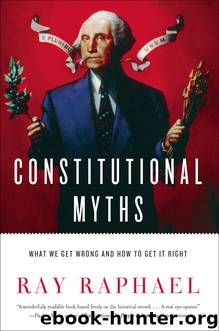Constitutional Myths by Ray Raphael

Author:Ray Raphael [Raphael, Ray]
Language: eng
Format: epub
Publisher: New Press, The
Justice Antonin Scalia, the Supreme Court’s other professed originalist, assumes a somewhat milder stance. “If a constitutional line of authority is wrong, he [Thomas] would say let’s get it right,” Justice Scalia said informally in 2004. “I wouldn’t do that. He does not believe in stare decisis period.”31
Justice Scalia’s theoretical defense of originalism is more discriminating, explicitly disavowing original intent in favor of original meaning: “I will consult the writings of some men who happened to be delegates to the Constitutional Convention—Hamilton’s and Madison’s writings in The Federalist, for example. I do so, however, not because they were Framers and therefore their intent is authoritative and must be the law; but rather because their writings, like those of other intelligent and informed people of the time, display how the text of the Constitution was originally understood.”32
Original intent, which Justice Scalia rejects, at least focuses on discrete and clearly identifiable sources, whereas original meaning opens the floodgates. Sources to examine include the papers of Washington, Adams, Jefferson, Madison, Franklin, and Hamilton (the most updated collections currently total 216 volumes, but they do not yet include a combined 108 years of their lives); smaller collections for many other founders; records of numerous local committees before and during the Revolutionary War; journals of the Continental and Confederation Congresses, the first few federal congresses under the Constitution, and state legislatures, as well as published letters of delegates to those bodies; twenty-two volumes of the Documentary History of the Ratification of the Constitution (with additional material not yet published); countless unpublished letters housed in local archives; extant newspapers for the latter third of the eighteenth century, with their flamboyant and often partisan writings; and of course dictionaries. Reasonably large samples of these materials must be explored if we wish to know precisely what “general welfare,” “freedom of speech,” “well regulated Militia,” “excessive bail,” “unreasonable searches and seizures,” “necessary and proper,” “regulate Commerce,” “Republican Form of Government,” or other such terms meant to the people of that time, or, in Justice Scalia’s words, “the original meaning of the text.” For a controversial passage, we need to discern how the disputed words or phrases are used in various contexts and then compare those contexts to the context within the Constitution. Rarely will we find a direct match, so even at its best, the results of our inquiry will be tentative.33
By substituting the generic “intelligent and informed people of the time” for the identifiable “framers” or “ratifiers,” Justice Scalia removes us from actual historical events with real protagonists, and this provides great license for conjecture and personal discretion. Diffuse materials are more readily mined for evidence in support of preconceived conclusions. The pursuit of original meaning does not always involve passive discovery, where the answer simply awaits us in the texts; more often, it is a determined act of construction, building an argument on behalf of a preferred interpretation. The greater the number and variety of sources to choose from, the easier it is to find material to fashion an argument.
Download
This site does not store any files on its server. We only index and link to content provided by other sites. Please contact the content providers to delete copyright contents if any and email us, we'll remove relevant links or contents immediately.
| African Americans | Civil War |
| Colonial Period | Immigrants |
| Revolution & Founding | State & Local |
Cat's cradle by Kurt Vonnegut(14754)
Pimp by Iceberg Slim(13769)
Underground: A Human History of the Worlds Beneath Our Feet by Will Hunt(11830)
4 3 2 1: A Novel by Paul Auster(11780)
The Radium Girls by Kate Moore(11615)
Wiseguy by Nicholas Pileggi(5310)
American History Stories, Volume III (Yesterday's Classics) by Pratt Mara L(5131)
Perfect Rhythm by Jae(5065)
The Fire Next Time by James Baldwin(5014)
Paper Towns by Green John(4785)
Pale Blue Dot by Carl Sagan(4612)
A Higher Loyalty: Truth, Lies, and Leadership by James Comey(4546)
The Mayflower and the Pilgrims' New World by Nathaniel Philbrick(4276)
The Doomsday Machine by Daniel Ellsberg(4240)
Killers of the Flower Moon: The Osage Murders and the Birth of the FBI by David Grann(4185)
The Sympathizer by Viet Thanh Nguyen(4090)
Too Much and Not the Mood by Durga Chew-Bose(4087)
The Borden Murders by Sarah Miller(4011)
Sticky Fingers by Joe Hagan(3906)
